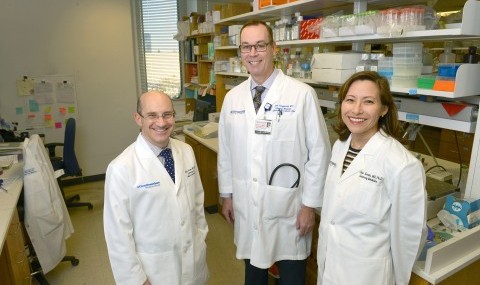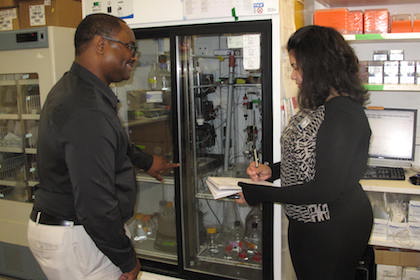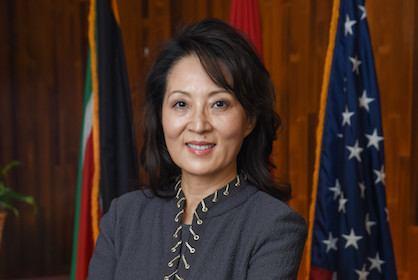UT Southwestern selected to join Pulmonary Fibrosis Foundation’s Care Center Network

DALLAS – Dec. 18, 2015 – UT Southwestern Medical Center’s Pulmonary Fibrosis Program is one of 40 programs nationally – and the only one in North Texas – to be selected to be part of the Pulmonary Fibrosis Foundation Care Center Network.
Pulmonary Fibrosis Foundation Care Center Network sites embrace a multidisciplinary approach that delivers comprehensive patient care through recognized expertise in pulmonary medicine, rheumatology, radiology, and pathology. The goal is for patients to benefit from a more accurate diagnosis, recommendations for continuing care, assistance in delivering essential social services, and the opportunity to participate in collaborative research.
“Pulmonary fibrosis, also known as interstitial lung disease, is a big category of 150 to 200 diseases that all lead to scarring and inflammation in the lungs,” said Dr. Craig Glazer, Associate Professor of Internal Medicine. “Treatment is very much dependent on getting the right diagnosis, and studies have shown that patients who are treated at a specialized care center like ours, where they can get to the right diagnosis, do best.”
Dr. Glazer is one of three co-directors of UT Southwestern’s program, along with Dr. John Fitzgerald, Professor of Internal Medicine, and Dr. Christine Kim Garcia, Associate Professor of Internal Medicine.
Pulmonary fibrosis causes scarring of the lungs, leading to symptoms such as shortness of breath, coughing, and fatigue. Symptoms can be easily misdiagnosed, making expertise in diagnosing and managing the disease crucial. UT Southwestern’s Pulmonary Fibrosis Program saw more than 350 new patients last year from all over North Texas, West Texas, Arkansas, Louisiana, Oklahoma, and the Southwest. “We are a regional center for diagnosis and treatment,” said Dr. Glazer.
No cures for pulmonary fibrosis currently exist. However, there are medications, exercise and pulmonary rehabilitation, and oxygen therapies that can help people cope with the disease. Pulmonary fibrosis is now the leading indication for lung transplantation in the U.S., according to the Pulmonary Fibrosis Foundation. UT Southwestern consistently ranks among the top 10 lung transplant programs in the country.
“A swift and accurate diagnosis, along with the highest quality of care, is absolutely critical for effectively managing this group of fibrotic lung diseases,” said Dr. Gregory Cosgrove, chief medical officer of the Pulmonary Fibrosis Foundation.
The Pulmonary Fibrosis Foundation Care Center Network also expands opportunities for research and discovery. For example, UT Southwestern patients can now participate in the Pulmonary Fibrosis Foundation Patient Registry, an electronic database of patient information that has been de-identified, or made anonymous, which can then be analyzed to better understand the disease and develop more effective care strategies and therapies. The Pulmonary Fibrosis Foundation Patient Registry is the only registry that includes data on pulmonary fibrosis of all types, not just the most common form called idiopathic pulmonary fibrosis.
“The registry offers a lot of potential to advance the full scientific understanding of interstitial lung disease,” said Dr. Glazer.
UT Southwestern has been a national leader in understanding the genetic underpinnings of a form of pulmonary fibrosis called familial pulmonary fibrosis. Dr. Garcia and colleagues have identified mutations in five genes – PARN, RTEL1, TERT, TERC, and SFTPA2 – that lead to familial pulmonary fibrosis. Mutations in these five genes account for about 25 percent of all cases of familial pulmonary fibrosis.
“Our ultimate goal is to gain a full understanding of what causes the genetic form of this disease so that effective medications can be developed,” said Dr. Garcia, holder of the Kern and Marnie Wildenthal President’s Research Council Professorship in Medical Science. “In addition, we anticipate that the network will provide opportunities to participate in research studies from across the country.”
Pulmonary fibrosis can result from exposure to asbestos or mold, radiation treatment, and certain medications. But in more than half of cases, doctors are unable to pinpoint a cause, which is labeled idiopathic pulmonary fibrosis (IPF). According to the Pulmonary Fibrosis Foundation, 1 in 200 adults over age 65 has IPF, and more than 50,000 new cases of IPF are diagnosed each year. Approximately 40,000 people die from IPF each year, according to the Pulmonary Fibrosis Foundation.
“Our goal is to find treatments that improve a patient’s quality of life, stabilizes or improves lung function, and lengthens survival,” said Dr. Fitzgerald, holder of the Elaine Dewey Sammons Chair in Pulmonary Research, in Honor of John E. Fitzgerald, M.D. “Being a part of the Care Center Network will help us continue on this path.”
About UT Southwestern Medical Center
UT Southwestern, one of the premier academic medical centers in the nation, integrates pioneering biomedical research with exceptional clinical care and education. The institution’s faculty includes many distinguished members, including six who have been awarded Nobel Prizes since 1985. The faculty of more than 2,700 is responsible for groundbreaking medical advances and is committed to translating science-driven research quickly to new clinical treatments. UT Southwestern physicians provide medical care in 40 specialties to about 92,000 hospitalized patients and oversee approximately 2.1 million outpatient visits a year.
###
Media Contact: Cathy Frisinger
214-648-3404
cathy.frisinger@utsouthwestern.edu
To automatically receive news releases from UT Southwestern via email, subscribe at www.utsouthwestern.edu/receivenews




